
Happy new year and all that.
I had originally planned to write-up one of those “year in review” style blog posts and maybe review some of my hobby-related accomplishments over 2018. It was, by all accounts, a rather good year for me hobby-wise, and really ticked off a lot of boxes. In the end though, I was a little preoccupied over holiday period, either spending time with relatives and loved ones or simply painting miniatures. I did manage to sneak in a little Twitter thread with the highlights though.
It’s been a pretty good year. Heading down to Warhammer World, playing at a new gaming club, getting a solid number of events and tournaments in, starting this very blog. So much happened in 2018 that for once it feels like the year didn’t just zoom past.
But enough naval gazing, let’s look forward to future hobby. With my Iron Warriors no longer looming over my head, I felt free to pick off a couple pieces of low hanging fruit from my backlog.

In terms of low-hanging fruit, you don’t get much more low hanging than this. Before I settled on Angmar as my Evil army, I flitted between a few ideas – one of them being Moria. There’s a lot of reasons Moria is such a cool faction – nostalgia factor for the miniatures (as with the Elves and Númenorians, they are the oldest sculpts in the game), absolutely loving the design of the Moria Goblin’s shields and helmets.. but, no. Let’s be serious here – the real reason is the Balrog. An amazing design, a powerhouse on the table and really one of the coolest monster models in the whole SBG. For whatever reason though, I decided I was more interested in the mish-mashed mess of muted technicolour flesh and rags that the classic (i.e. not Morannan) Orc brought to the table – which left me with the final decision between Angmar and Barad-Dúr. Knowing that I was going to be lending out this army a lot while my friends got their own armies painted, I decided against the idea of playing against Sauron in just about every game and opted for the more sensible and thematically compelling Angmar.
Not before I bought a bunch of ‘pro painted’ Goblins in eBay though; and thus they were doomed to live in a box at the top of my hobby closet for months until the day came when I decided to run a Moria-themed narrative game. Or in this case, when I had nothing necessarily more pressing to do.
Being already ‘pro painted’, there wasn’t an awful lot of time wasted on fixing these guys. Unlike my renovated Orcs, these Goblins did not require me to go through and remove excess flash and mould lines (and subsequently reprime and touch up the now bare plastic), which saved an awful lot of time. They did, however, have some pretty gnarly bases, a weird gloss-sheen to them and their armour and clothing was a bit bright and undefined. My first step then was to texture over their bases with some Vallejo Mud Texture. When that was dry, the whole model – base and all – was given an Agrax Earthshade wash. Thanks to the weird gloss finish (either from a varnish or maybe even enamal paints), the shade tinted the minis only a little and largely settled in the major recesses, improving their definition. It did help however to remove some of the shiny finish, and made a second coat in some of the areas that needed a bit of darkening settle a bit more evenly. With this done, I was able to re-sharpen the edges of the metals, hastily pick out the edges of cloth and correct a few of the faces before drybrushing the bases, gluing down the leaf scatter and sealing them with Dullcote – and properly eliminating the glossy issue once and for all. When that was dry, I stuck some snow effect to the top of the base and a magnet to the underside and called it a day.
The whole endeavour took about an evening all in, and I’m pretty happy with them as far as Goblins go. While I have no immediate plans to run a Moria army, it’s always handy to have some Moria Goblins about for running Fellowship narratives – and I expect I’ll likely knock out a Goblin King and Goblin Command at some point as a fairly low effort means to making this a decent standalone force (along with my 3 Cave Trolls, of course).
After knocking out those Goblins, and still on a Middle-earth kick, I decided to root through my boxes and see what odds and ends I had to tie up. One of these was my Mounted Arwen.
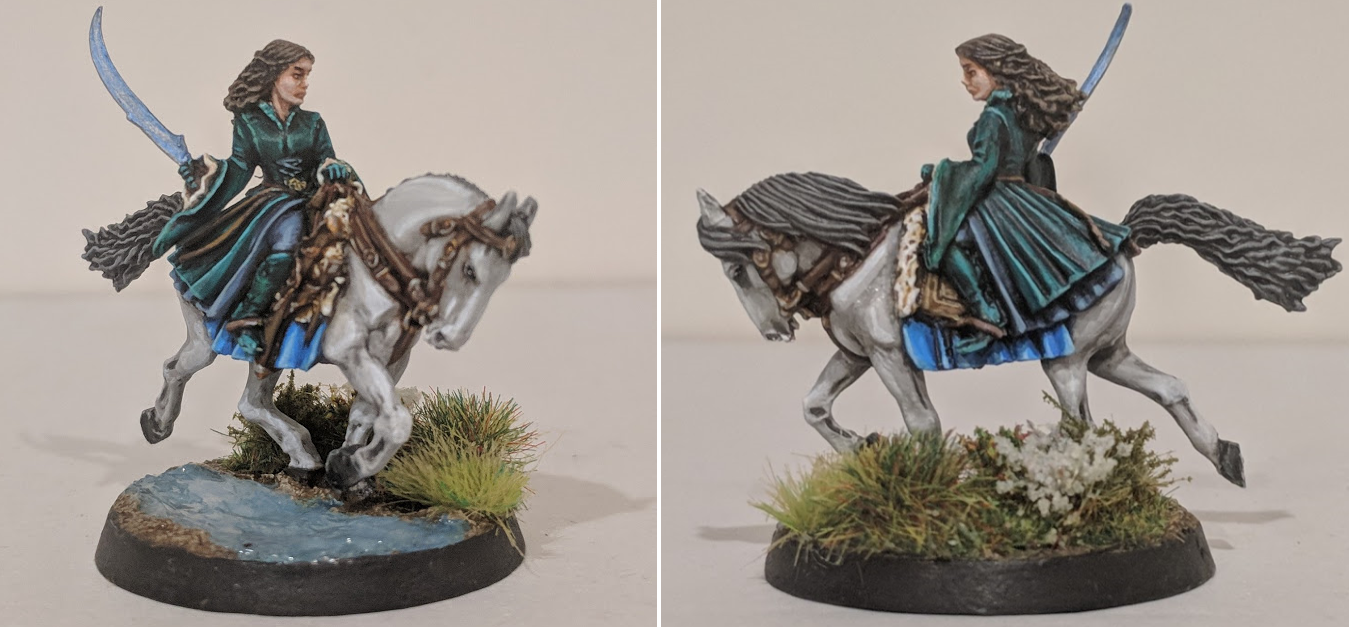
I’m pretty proud of how this one turned out in the end, though it was something of a struggle. I’m never 100% confident painting female faces, as I think you need to be a little more deliberate to get them defined correctly. I did learn a lot painting the Arwen on foot miniature (who I’m largely happy with, even if my several coats and do overs resulted in her having a slightly chubby face), but I had an additional challenge with this one – there was a bit of a mould slip with the casting of this, and the seam ran right down her face. As is often, bizarrely, the case with me – I didn’t particularly notice this until I started painting the miniature. While some of the slip was easy to clean away, the face was.. nightmarish. I had originally tried to paint around the issue, hoping to disguise it with paint alone, but the face – for lack of a better description – always looked a bit like she just had a stroke. Looking through my phone, it appears I made the poor judgement call of deleting the ‘before’ photo, but you’ll have to take my word that it was pretty monstrous. Eventually, I scraped away all the paint on the face with my x-acto blade3, much like I had to do on my foot Arwen, and made some very careful alterations to the face – levelling the mouth and nose and smoothing the forehead – before re-applying brush on primer and attempting to base, shade and layer the face up again. It took a few attempts, and still required a bit of careful painting, but I’m now largely happy with how her face looks, particularly in the profile shots above.
Thankfully, the rest of the job was considerably more straightforward, and virtually the same process as painting Glorfindel’s mount and Arwen on foot. For her base, I gave her both the bushier style that I used on Mounted Glorfindel and the water feature style that I’d used on most of Elrond’s household – the bushiness sort of winking at Glorfindel and Arwen assuming the same roles in the books and movie respectively, I thought.
With mounted Arwen done, I had finally cleared my entire Rivendell backlog, or at least those I had on hand4. I had a bit of a feeling that I had some Middle-earth goodies coming to me over Christmas, and so neither wanting to switch gears nor commit to a huge project, I opted to tackle my mounted Aragorn miniature for my upcoming Grey Company force5.
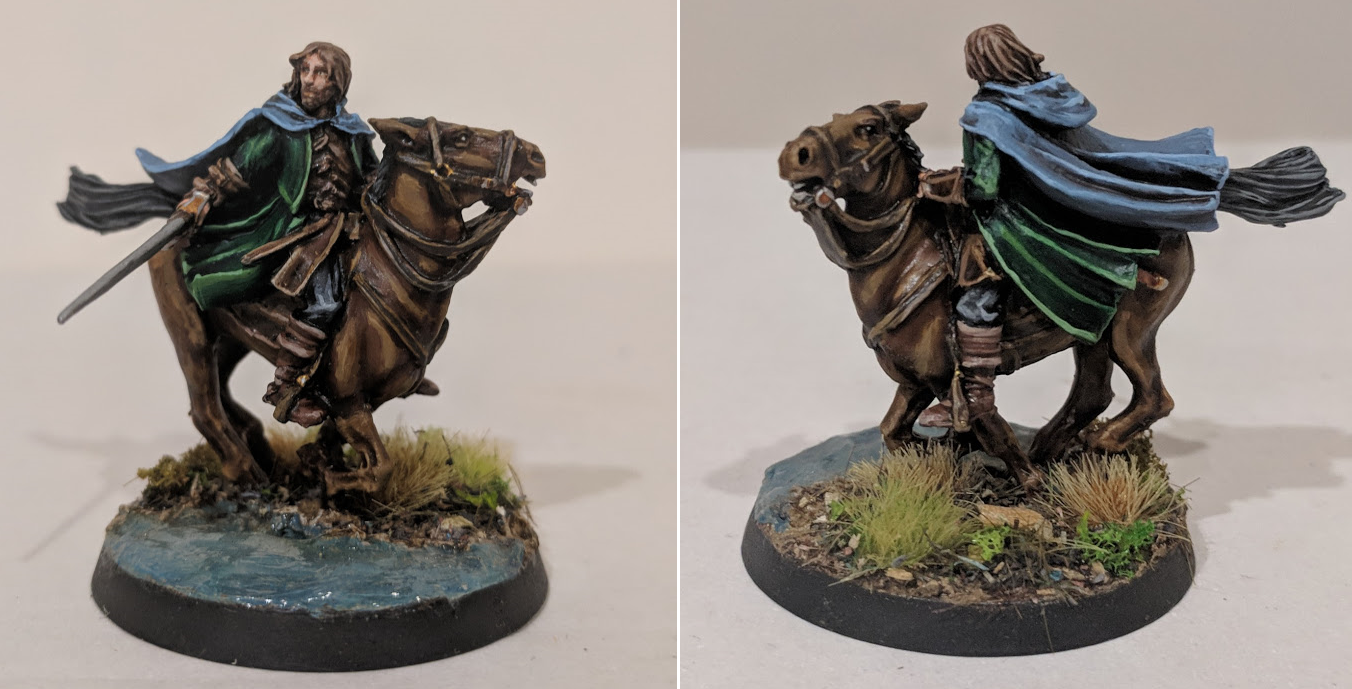
Mounted Aragorn was a bit of an interesting challenge, because I wanted his horse to be a dark brown, to match Brego from the films. It wasn’t until I started painting that it occurred to me that I hadn’t actually attempted to paint a horse in any colour other than white! This posed a few challenges, as I had to pick a new palette of colours to match from, and try and keep the brown leather saddle, reigns and harness visible, and prevent them from blending too much into the horse. On top of that, Aragorn himself has a lot of brown leather himself. In the end, I tried to keep Brego to a consistent, chocolately kind of brown while making the reigns and saddle a much darker brown with reasonably high contrast edge highlighting. Arargorn’s leathers themselves are my usual character leather – Dark Fleshtone with an Agrax Earthshade wash, then a mix of Dark Fleshtone and Beastly Brown layering with some Elfic Flesh added for highlights.
I tried to keep this Aragorn as close to the one I painted for that Balin’s Tomb diorama around December 2017, on the basis that – at the time – I was planning to use that Aragorn as the dismount. One major difference was the inclusion of his cloak on this particular miniature however. As I was planning on fielding him around the time of Pellanor Fields with the Grey Company, I knew I wanted it to be grey of a sorts – there were a couple of other considerations though. I knew I was going to want to field him with my bright and colourful Rivendell from time to time, and indeed he would be fighting side-by-side with Elladan and Elrohir in the Grey Company army. Secondly, whether by accident or not, I’ve done a reasonable job thus far of keeping my Good and Evil forces with a decent aesthetic theme, with my forces of Good being very saturated and colourful, in contrast to the muted, earthy and drybrushed tones of my Evil. With that in mind, I decided to be bold and give Aragorn a kind of Space Wolves grey, with a bit of a baby-blue tint to the grey, rather than a pure black/white greyscale cloak. I think this will make Aragorn and the Dunédain Rangers blend a little better in with my Rivendell Elves, as well as make them a little more distinguished and vivid compared to my forces of Angmar.
It was around this point that I decided Aragorn deserved a new dismount miniature. My Balin’s Tomb diorama would remain just that – a display piece for my mantlepiece, and not miniatures I would risk chipping with play (I always chip something). Much as I love the original sculpt for Strider, I decided to scour eBay and pick up the original Three Hunters set and paint up what I think is perhaps the definitive Ranger sculpt for the Heir of Isildur.
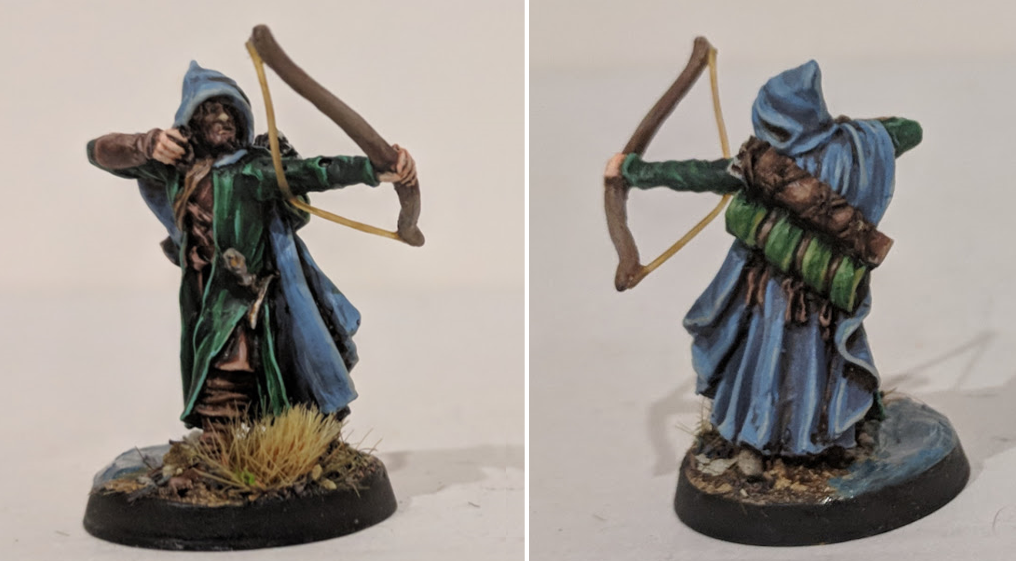
I absolutely adore this sculpt of Aragorn – while the upcoming plastic Three Hunters set looks absolutely spectacular (and the Boromir Bracers are a great touch for a Pellanor-era Aragorn), I feel this one both matches the cloaked horseback miniature well, but also absolutely screams Ranger of the North. The bow, the raised hood, the suggestion of Andúril sitting there in the concealed scabbard. It’s perfect.
There’s not a lot to dwell on with this particular miniature that I haven’t already talked about on the mounted version, although I am quite pleased with how much feature I could fit onto his 25mm base. The previous owner of this miniature (I bought used, assembled and primed, as it was out of production) assembled the bow arm at a jaunty angle, which I think does look better – but it made adding the bowstring a bit more difficult, and required a little subtle heat bending, and looked a bit funny with the string in rest position – which is what led me to glue it as if an arrow had just been loosed.
After Aragorn, Christmas finally arrived and I was very fortunate to receive some all important Wraith support for my Angmar army. In fact, I couldn’t have asked for a better haul – between my fiancé and her mother, I received not only The Witch King of Angmar (on foot, and mounted) himself, but also the Tainted and the Dwimmerlaik – and my first true centrepiece of the army – a Nazgul on Fell-Beast model! I also received a number of GW gift vouchers from her brother and my own mother, which will be going towards either Gûlavhar, the Terror of Arnor or perhaps the new Gondor at War supplement at some point. However, in the mean time, I had a nice selection of Evil goodies to get through and I was excited.
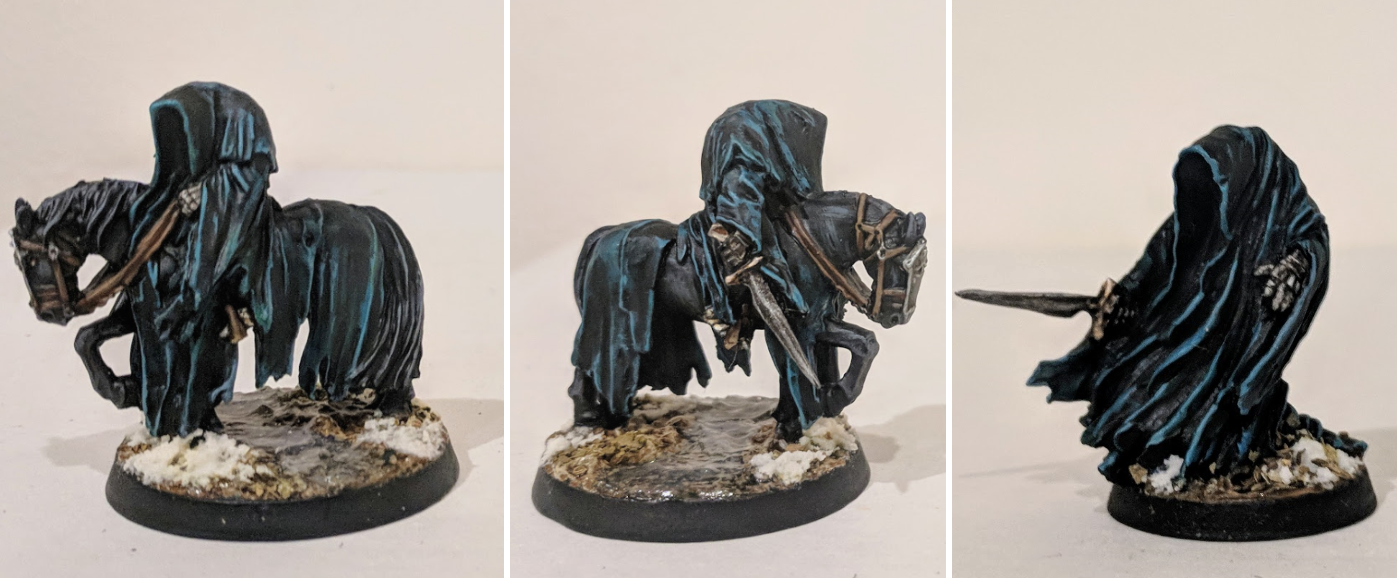
For me, playing Evil is really all about two things – access to big, awesome centrepiece miniatures such as Fell Beasts, Trolls and Dragons that you really don’t get any of on the side of good6; and Nazgul. I’ve never really been particularly excited by ghosts, spirits or apparitions in evil fantasy factions (though I do like the oathbreaker element to the Army of the Dead, particularly as a ‘Good’ faction), but for whatever reason, Nazgul have always been a major highlight of Tolkien’s Legendarium for me. Maybe it’s parable of it all – great Kings of Men, baited by the promise of power and deceived into submission to the Dark Lord. Perhaps it’s the Black Rider aesthetic, that they don’t necessarily appear as ethereal or ghostly in any way, but as menacing black cloaked figures. Hell, maybe I just love Weathertop and the Flight to the Ford. Whatever the reason, Ringwraiths thrill me aesthetically and being able to polish off the named characters available to Angmar and add a proper centrepiece miniature all at once was some terrific hobby synergy.
The first one that I decided to attempt was The Tainted. I had a look on Games Workshop’s site to get a little inspiration for how to paint this one, and the subtle colouration in his robes really set me off. I decided that what I wanted to do with all my named/non-generic Ringwraiths, was I was going to give them all a separate and unique tint to their highlights. In the case of The Tainted, he has a real spooky, sickly look about him so I opted to give him the most colour of the lot, and paint him in a very similar fashion to how I did my Sauron the Necromancer (which you can check out as uploaded by plastic_cracked on the Games Workshop webstore now). My process here is really simple – from black, I make really rough, kinda watery broad strokes across all of the folds of a dark blueish turquoise, and then successively make more opaque, lighter and finer highlights. Somewhere down the line, the whole thing gets a Biel Tann Green wash, which helps tint it and the wash smooths out the highlights a bit, making the more recessed areas darker in a natural sort of way. After the wash, I take things a little more seriously and start edge highlighting in a more traditional, focussed manner. As far as the horse goes, The Tainted was the easiest of the three to get this right – his highlighting was the least traditionally grey, which made painting a black horse and having him distinguishable from the robes a lot easier. My final aesthetic liberty I took was painting the reigns and harness on the horse brown, like all my other horses; there was too much black on the miniature already, in my opinion, and a flash of brown made things more interesting to look at. It’s a similar reasoning to why I always insist on painting my sword hilts gold/brass – Morgul Blades and Andúril alike were depicted as having grey steel hilts, not a million miles from the colour of the blade itself, but a completely monotone blade just looks a bit monotonous on a miniature of this size, in my opinion – at least for a modeller/painter of my calibre.
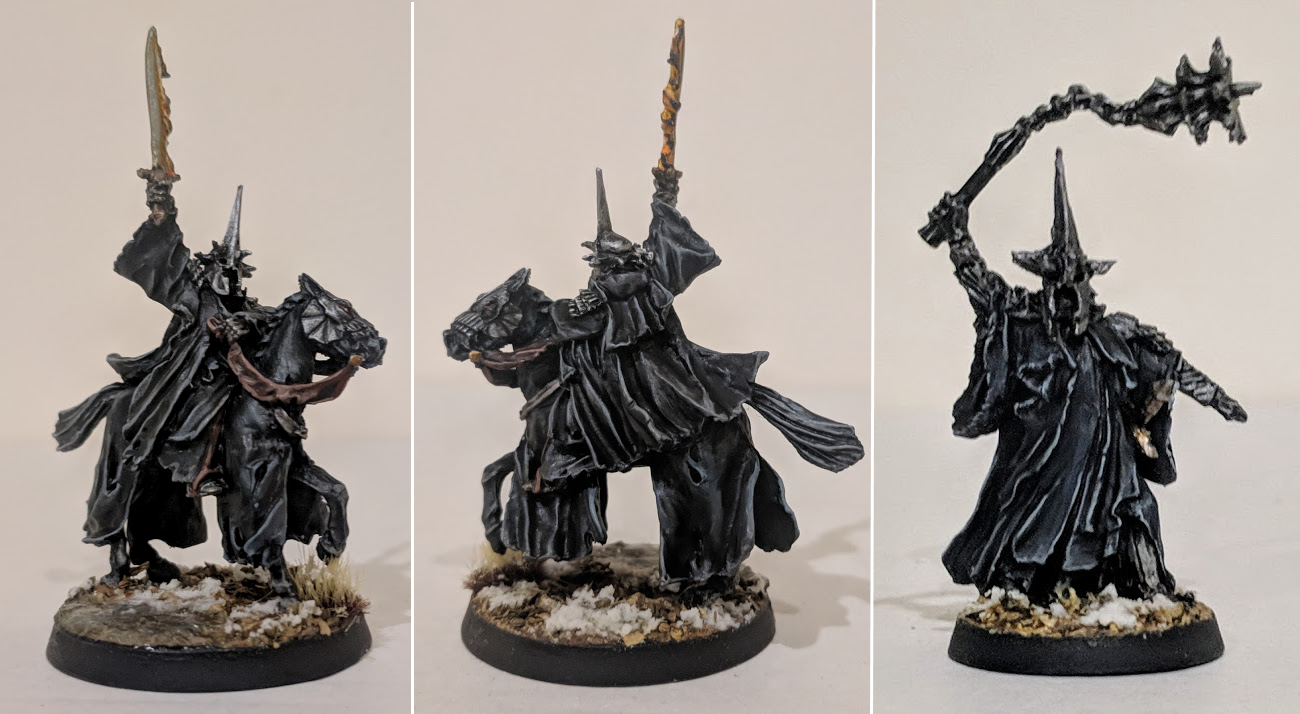
Following The Tainted came the Witch King of Angmar himself. This was the only miniature of the three to come in Finecast instead of metal, and I yet remain wholly undecided as to whether I prefer working with this material over pewter/white metal. There’s an undeniable feeling of quality with pewter that comes with the sheer weight of it, but the practicalities of playing with it have become all too apparent to me after a few games – the rigidity of the material makes it considerably easier to chip, either from impact or bending, and the weight can make it a little riskier to transport.
I prefer to use magnetic transportation solutions wherever I can as I’ve snapped more than my fair share of spears on foam packing in the past, but there’s a teething period with magnets while you figure out how many you actually need for any given miniature. On one of my first outings with my Angmar army, a Cave Troll came loose and rolled over all my other character/metal miniatures in transit, creating several hours of work to touch up and fix the chipped miniatures. Buhrdurs fur has never really looked the same since, unfortunately. Additionally, metal can be challenging to spot imperfections in until it’s primed and you start painting, which can be difficult to fix afterward. Games Workshop’s metal in particular seems very prone to these tiny strands/tendrils of metal that need trimmed off carefully – any sharp edge left on tends to repel paint, even primer, and is a chip waiting to happen.
Finecast has it’s own set of problems, however, and has something of a reputation for them. Although there’s been a great deal of improvement in Finecast7, there remain some older models form the range which are nightmarish to work with – the Witch King of Angmar was one such model. The had a nightmare of a time with this guy. Most of my issues were superficial and a bit annoying at the time, but the one that I remain salty about was just what an absolute pigs ear the mould made of his Morgul Crown – on both the foot and mounted versions, the crowns spikes were deformed and moulded together in a horrible slant, as opposed to the crisp L shapes intended – a defect that becomes especially apparent when you compare these miniatures to the plastic Witch King on Fell-Beast. This detail was way too fine to do anything meaningful about with a bit of hot water either, and in the end I pretty much had to make do. I learned a hard lesson with the crown on the on-foot version of the Witch King, where I broke off the spikes and had to resculpt them myself with green stuff. I’m clearly not an expert in this area, but it’s not a million miles worse than the untouched Finecast anyway. The final annoying issue with this miniature was the mounted versions sword – I could not for love nor money figure out how to fully straighten his flaming sword. This is a weirdly common issue with LOTR finecast sculpts, as I had similar issues with my Mounted Elrond miniature’s sword, though this one was further complicated by the flames. I think I did an alright job in the end, though it looks a little wonky at certain angles.
As the big kahuna of the Angmar list, The Witch King was probably my most important of the Nazgul, but also the only one who’s unique named model was actually based on his likeness in the films. For this reason, I decided to highlight him in a more standard grey-scale fashion, and highlighted him in a similar method to The Tainted, though using only Black, Dead White, and Nuln Oil as paints/wash. This made painting his horse a bit more difficult, as the colours all sort of blended into each other a bit, and the only non-metallic colours other than those on the miniature itself were on his flaming sword and the leather harness/reigns on his horse. The reigns looked a little more like the cloth draped on the horse itself than the standard straps of the Tainted’s horse, but I decided to stick with brown for those as the model desperately needed a little of that. In retrospect, adding some mud and dirt to the bottom of his robes might’ve went some way to breaking up the colours on the model, and I may choose to revisit that at some point if I feel comfortable enough messing with a finished model. Lessons learned, I suppose. I learned a bit about painting flame as well on this mini – which transferred nicely over to his Fell-Beast variant, I think. The finecast version of the models flame effect on the sword is somewhat diminutive though, unfortunately, and it’s hard to get a decent gradient, but my method was essentially starting from yellow, with some blobs of white in the very centre of the flames, and an orange drybrush towards the end, followed by a light drybrush of black for the smoke/soot. I’m reasonably pleased with how it turned out – the flames came out a little bit more desaturated than I intended, but I do think it suits the aesthetic of the army I’ve built better anyway.
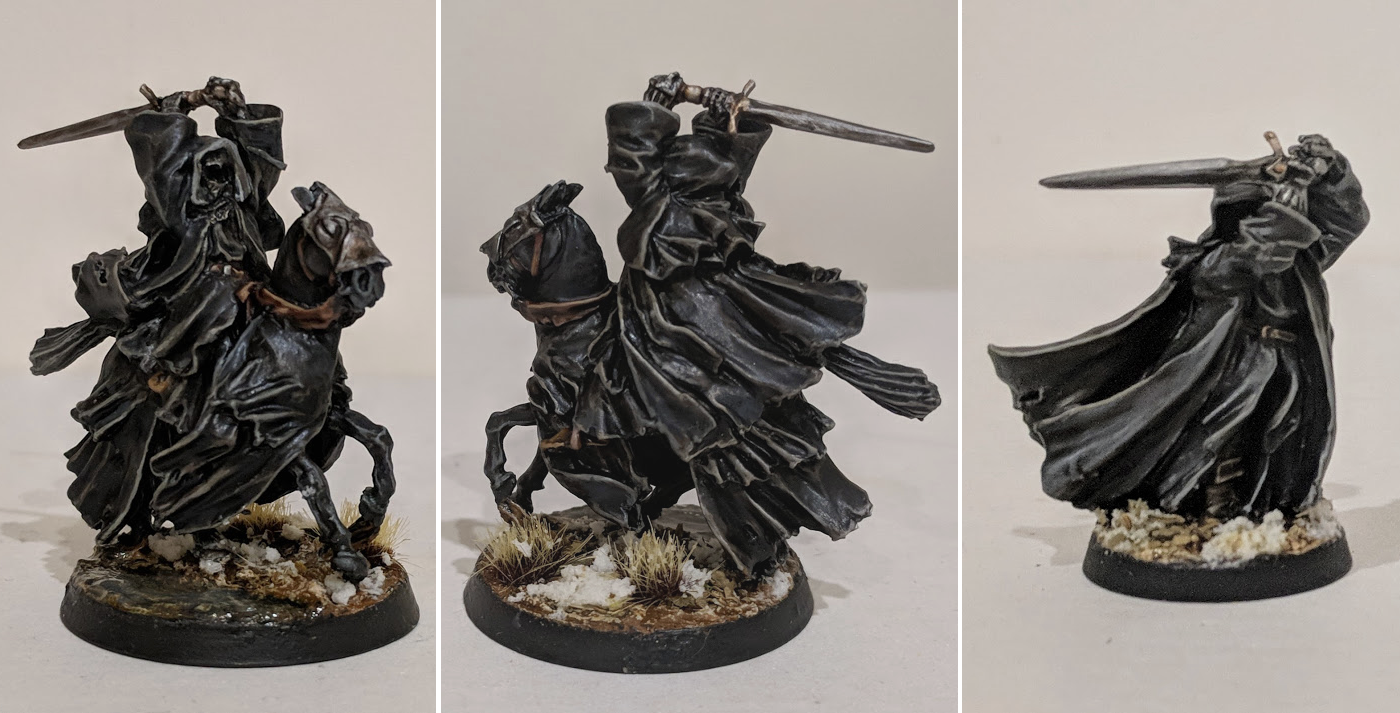
Back onto metal again, The Dwimmerlaik was the last of my Nazgul. I’m not sure how well my photography captures it, but the slight deviation to colour and highlighting I went with on this guy was to use Beige (specifically Bonewhite and Elfic Flesh) as my tint to Black rather than Dead White, and I washed the highlights with Agrax Earthshade instead of Nuln Oil. I didn’t have much of a plan for how this was supposed to look, only that the highlighting would be a tiny bit warmer than the cold grey of the Witch King – but as I was painting the miniature, I found the beige-tinted black had the effect of looking a little bit like leather. I really liked how this looked on this particular wraith with his prominent leather boots and belt. While not super clear in the photography above, I decided to capitalise on this a bit and sealed this particular wraith with a satin varnish after the Dullcote was applied, giving it a mild shine – less matte than the Witch King, but not really a gloss. Just shiny enough for leather robes.
I had similar issues highlighting this guy as I did the Witch King in that his robes and his horse were very prominent on the miniature. The highlights being essentially a grey, I found the horse blended in a little bit with the robes again – albeit to a slightly lesser degree than The Witch King, thanks to being highlighted with a slightly different tint to the robes. Knowing then what I know now, I probably would have made more of an effort to highlight the horses fur with an obviously different tint on both miniatures than I used on their robes and horse cloth, and again, applied some weathering to the bottom of their robes, but I’m still pretty happy with how the shading came out in the end. Still, much like the Witch King, I’m considerably happier with how well the dismount came out in the end than the mounted version.
A final comment I want to make about the three named Nazgul is on their bases – I rather like the dingy leaf litter and snow basing scheme that I’d been using thus far for my Angmar models, but I found myself missing the water effects that I use on a lot of my Good miniatures. It’s a really simple basing effect, but it’s one that gets a lot of really positive attention from others, and feels like it’s become something of a trademark of my Middle-earth miniatures. I perhaps missed a trick not using this effect on Buhrdur and the Hill Trolls. These being my first Cavalry models for my Angmar army – and characters none the less – felt like a nice opportunity to go back and correct this failure. Keeping with the more muted palette of my Evil forces however, I simply gave the water sections a quick wash of Athonian Camoshade after drybrushing the base – this gave the water a more subtle appearance than the bright blue of my Good armies, which I think worked well with the arguably already busier base (between the snow and leaf litter), as well as a grittier, more realistic appearance of running water – it almost puts me in mind of the forest landscape of the Ambush at Amon Hen from the Fellowship movie.
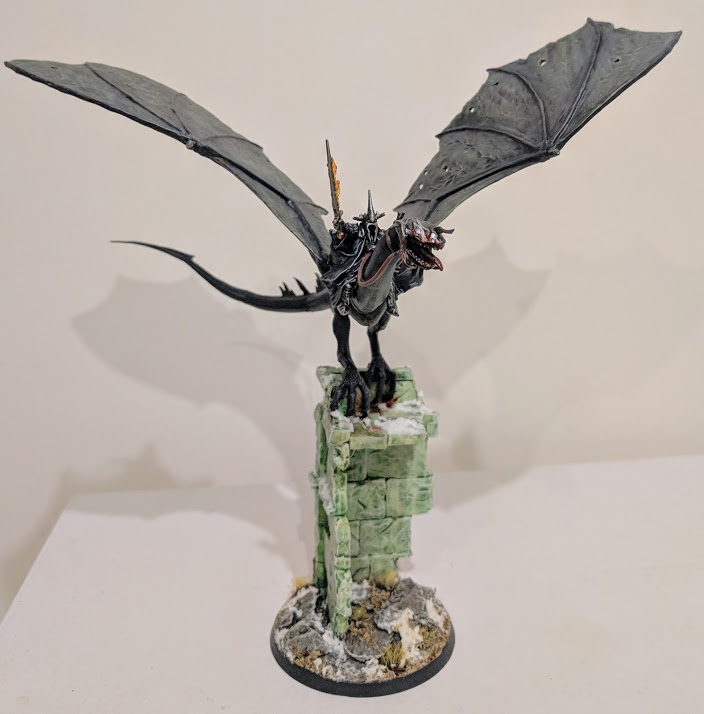
Having gotten a little experience painting Nazgul, it was time to move onto the big guy – the Witch King on Fell Beast. As this was going to be the Big Bad Hero of Legend of my army – being the Witch King of Angmar himself, and on one of the biggest and fanciest mounts in the game (short of a War Múmak or Great Beast of Gorgoroth), I wanted to do something a little special with the miniature rather than simply put the kit together straight out of the box. The easiest solution to this being – give him a better base!
I’ve never been the biggest fan of flying stands. I’m not really opposed to how they look, but anything that’s not stuck firmly to a base is often a pain in the arse to hold throughout priming to painting to sealing, and the amount of times I’ve managed to get paint or matt varnish on the stands is.. too numerous to count. In that regard, I have largely appreciated Games Workshop’s recent trend of utilising little bits of scenery on bases to connect flying or leaping models to the base, even if those joints tend to be a little flimsy – you can always pin them. My solution, however, was a set of Osgiliath Ruins. The original idea for this was to rip-off an officially merchandised child’s toy play set, although a bit of dry fitting informed a decision against messing with the Fell Beast’s wing joints. This meant the pose had to make sense with the Beasts ‘flapping’ pose – and so I had the idea of him coming in to land.
The base itself was the most suitable looking piece of Osgilliath Ruins that I could find, cut to a reasonable size for fitting on the base. The base itself came as a premoulded scenic thing on the sprue, so I filed it down a bit with an emery board and used texture paint to hide the gaps between the ruins and the base. I also super glued down a bunch of pieces of slate – partially to blend with the texture paint and make the base look a little more interesting, but primarily for their weight. The Fell Beast is long, with a big wingspan, and I was planning on attaching it to the top of a tall corner building in whichever manner looked the best – the pieces of slate helped weigh the base down and give it a lower centre of gravity and keep it stable.
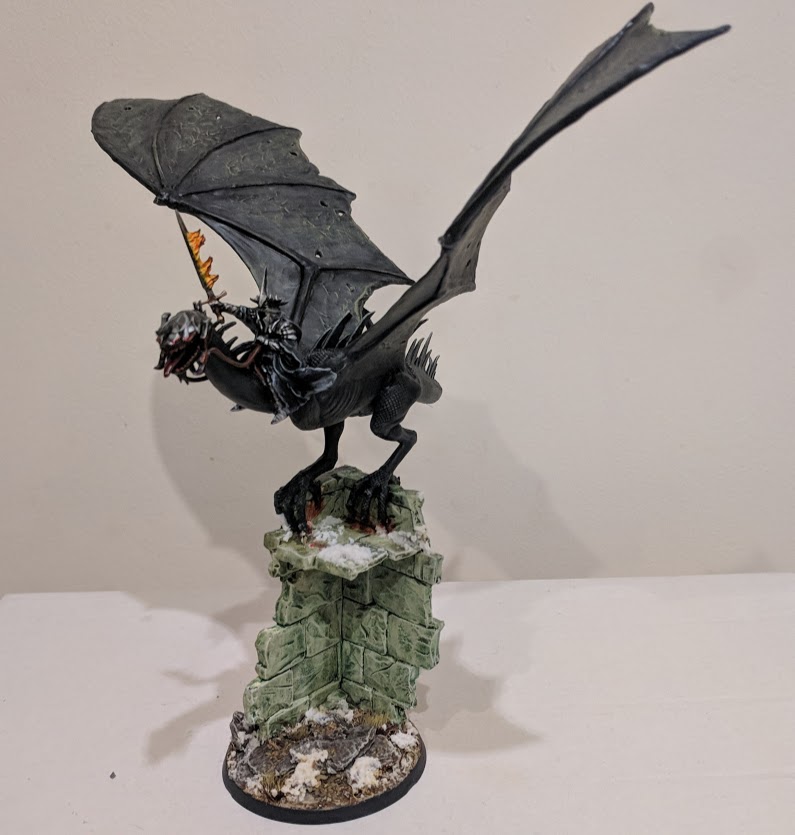
Thankfully, being a plastic kit, the Fell Beasts legs were relatively painless to repose and attach. No cutting was necessary, and the claws themselves actually fit quite nicely onto the ruin; the ‘coming in to land’ pose meant that I didn’t need the claws to look like they had a firm grip or anything yet, and I had a solid amount of contact points from one of the feet having two talons (the front and rear ones) ‘clip’ on either side of the wall, while the rear claw had a solid palm connection to the ruin. I tested the pose with a dry fit, and once I was happy with where the legs went, I stuck a glob of green stuff with a little super glue inside each thigh to increase the contact area, and put plastic glue around the edges of the thighs. There was a decent amount of plastic to plastic contact, and the green stuff helped keep things together and stiff while the poly cement did it’s thing and created a proper bond. Finally, I threw a little more super glue in the gaps to add a little more interior strength before covering the remaining gaps with green stuff, and doing my best to smooth it over to look natural.
Something about the long, outstretched tail really wasn’t working for me in this pose, so I decided to take on the task of reworking the tail a little bit to be curled forward, perhaps as more of an air brake. This was a bit terrifying, if I’m honest, as being plastic and not resin meant I couldn’t just heat bend it (although I imagine I could if I raised it’s temperature a bit higher, come to think), so I opted to slice it into four sections, file them at a bit of an angle and green stuff over the gaps. This sculpting work was surprisingly trivial – smoothing over the outside of the curve was a simple job of using my craft knife like a rolling pin to create smooth bends, while the inside didn’t matter if it was a little bumpy, as the skin would fold anyway. On the upper side, I had to very finely slice a shallow lattice in to match the scaly texture, which also proved pretty easy and blended rather nicely after taking some paint. The repose was worth the effort, in my opinion, and helped make the landing pose look a little more original and dynamic, though it’s not a perfect effort – although I filed and smoothed out the corners, the tail does look a little bit like there is 4 bends rather than one single smooth curve, but not so much that it ruins the effect.
As a Hero of Legend and the King of Angmar, The Witch King was always going to be my preference for this kit – it just feels wrong not to give the only Hero of Legend in the list the biggest and flashiest miniature in your army. That being said, the Fell Beast kit very pleasingly contains two options – the other being a generic Ringwraith on unarmoured Fell Beast with a slightly different pose – and both options are entirely component complete. What I mean by this is that they don’t share any irksome little component, like a connecting neck piece, and you can build both heads entirely separately without any need to rebuild anything with green stuff or the like – a prime candidate for magnetising!
I drilled a hole in the body and base of the neck of each head and installed a 2mm magnet in each with a bit of green stuff to help secure it in place – the extra friction of which helps keep the heads in place and not flop upside down due to the weight of the Nazgul on top. It’s a bit fiddley to get the holes bored to the right diameter, and as such the neck isn’t in 100% alignment on either piece, but it’s close enough and the legs of the Nazgul do a great job of hiding the seam for any really visible portions.
From a painting standpoint, this was a really fun miniature to paint, and I applied very similar techniques when painting it as I did with my Cave Trolls. The Beast itself was primed black, and touched up in various places that I missed with Vallejo brush on Surface Primer. The next thing I tackled was the underbelly, which was done with very light, very dry drybrushing in several layers, using a mixture of Vallejo Dead Flesh and Black paints, each successive layer adding a little bit less black, until the final drybrush with just a little white added. Each layer of drybrushing was done with slightly shallower strokes to try and get a little bit of a gradient to it. After the underbelly was finished, I turned to the wings – the membranes were painted with a couple thin layers of Vallejo Cold Grey and given an Agrax Earthshade wash, followed by a drybrush of Cold Grey again. After that, I drybrushed the entire Fell Beast with Dead Flesh, paying particular attention to the wing membranes and trying to be quite light on the scales themselves. This was then followed by an all over wash on the topside with Nuln Oil, taking care not to spill much on the underside or the wing membranes8, to darken and smooth everything back down again – I didn’t want the beast to come out overly fleshy, after all. When the wash dried, I did one final very careful drybrush over the Fell Beast in a number of key locations to smooth out the finish from the wash, and bring up the highlighting in the most extreme areas again.
That was just about all there was to the Fell Beast. Beyond that, it was just like painting the mounted Witch King miniature before it – drybrush the robes, wash them with Nuln Oil, and carefully edge highlight the extremities. Dark Fleshtone reigns, Agrax Earthshade wash, and a little Beastly Brown and White mixed into Dark Fleshtone for the highlights. I applied some of the lessons I learned from the mounted Witch King miniatures flaming sword here, and I think the flames came out much better, with a nice blend of sooty orange on the outside to a brighter yellow closer to the blade; some of this is down to the larger volume of flames on this miniature giving me a little more space to work with, of course.
For the base, I decided against painting the ruins exactly like Osgiliath – the grim, bare soil and snow content on the bases of my Evil miniatures is supposed to be representing the Fell Kingdom of Angmar, so I decided to paint the ruins in a spooky green fashion, befitting such a foul and loathsome place.. and quite obviously inspired by the set dressing in the photography in the Armies of the Lord of the Rings book. For the base itself, I painted the stones in Mechanicus Standard Grey and the soil the usual Vallejo Earth, shading the whole thing with Agrax Earthshade before a quick Khaki Drybrush, followed by a bit of Heavy Bluegrey and Wolf Grey on the stones. With that, the miniatures paintjob was completed, and so taken outside for a couple generous layers of Testor’s Dullcote. When the varnish dried, I glued a few Army Painter Wasteland Tuft9 to the base, followed by a few carefully placed scatters of dead leaf litter. When dry, I applied some blobs of Valhallan Blizzard across the ground and settled in some of the recesses on the ruin. The final addition was a little Blood for the Blood God on the Fell Beasts talons and mouth – an effect I’ve thus far restrained myself from using on my Middle-earth miniatures, but one that felt appropriate for the beast. With that, the miniature completed.
Phew! And that’s us completely caught up now with my hobby since mid December into mid January – congratulations and thanks for reading if you’ve made it this far into this somewhat mammoth post. Next up on my painting table is the very last bits and pieces for my Angmar – 8 Warg Riders (and 4 dismounted Wargs), followed by.. who knows? I have an Age of Sigmar tournament coming up this month, which may lead to me wanting to dig into my Skaven or Maggotkin armies some more, and add some new miniatures. Alternatively, I have some Halbarad with the Evenstar Banner and 10 Grey Company Rangers to paint up – which may be escalated to the forefront when the Gondor At War supplement drops for Middle-earth SBG; a modest force of Talon’s of the Emperor allies to add to my Heresy-era Space Wolves; a Rat Ogre and Hakflem Skuttlespike to round out my Skaven Blood Bowl team.. and there’s the small matter of that new Blood Bowl Orc booster from ForgeWorld which I’ve been waiting for to fill out Turghallz Toofspittaz. And come to think of it, I wouldn’t mind adding a couple of Castellans to my Dol Guldur army or a mounted Gil-Galad to my Rivendell…
2019 is going to be a fun year for hobby, I think.
Thanks for reading, and happy wargaming!
1 Well, listened to, in audiobook form. Usually while painting.
2 I forgot to include the miniature I painted for my fiancés christmas in the number on my Twitter page.
3 One of the very few advantages of a metal miniature’s propensity for chipping
4 There are a few pieces I’ve yet to paint for the army: Gildor and a warband of Wood Elves, whom I don’t really care to do any time soon; Lindir, who is yet out of production and has proven thus far too rare and difficult to obtain; armoured Glorfindel, who I’d like to do at some point, though would largely be a duplicate/aesthetic decision. I’m also missing a Mounted Gil-Galad and Armoured Glorfindel, though there are no models for them yet. I do plan on obtaining the excellent mounted Gil-Galad sculpt from Unreleased Miniatures at some point however – it both matches the Citadel aesthetic close enough while looking suitably regal for the baddest Elf in the Rivendell army list though. I just wish they still did their Mounted Armoured Glorfindel sculpt too.
5 Yeah, I’m planning a Grey Company army. After painting my Dol Guldur force on a bit of a whim, I wanted another low model count army to play with for my Good side, just to keep things fresh. I’m going for Grey Company for my second good force because it not only allows me to utilise some miniatures that I already own, such as Elladan and Elrohir, but also gives me access to some of the cooler big bad good guys such as Aragorn – whom already ally well with my Rivendell force. Collection synergy is good. Beyond that, you’ve got Rangers of the North to keep things at a nice low model count and potentially Army of the Dead allies, who shouldn’t be too difficult to knock out en masse if needed. Finally, it’s a force that was present at Pellanor Fields – meaning they’ll have a place as a new proper faction with new proper rules in the upcoming Gondor at War supplement. Should be a fun project to follow my second batch of Angmar reinforcements!
6 Outside of specific “Good Monster” factions such as Great Eagles and Ents, of course.
7 The Festus the Leechlord and Harbinger of Decay miniatures that I have in my Maggotkin of Nurgle army, for example, are absolutely wonderful. A few irritating and hard to find gates to remove under the protrusions – not dissimilar in a way to the tendrils on pewter – but stunning and crisp detail without any horrible mould lines or broken pieces.
8 I realise I’ve just typed ‘membranes’ an awful lot of times here.
9 For Angmar, I tend to use Mountain Tuft on the bases of my Orcs and Trolls, which looks suitably dead and barren. I reserve Wasteland Tufts for my Nazgul and Spirit miniatures – a subtle visual cue to their particularly dark and insidious corruption.

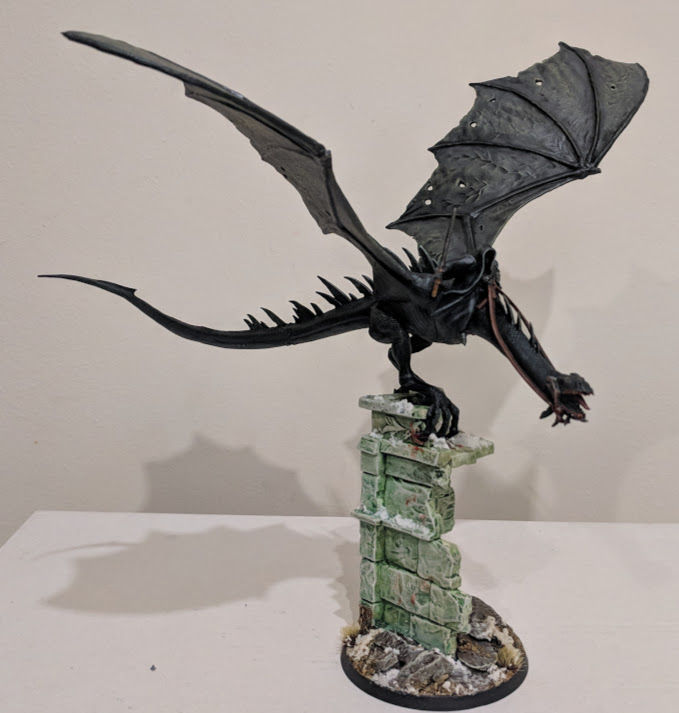
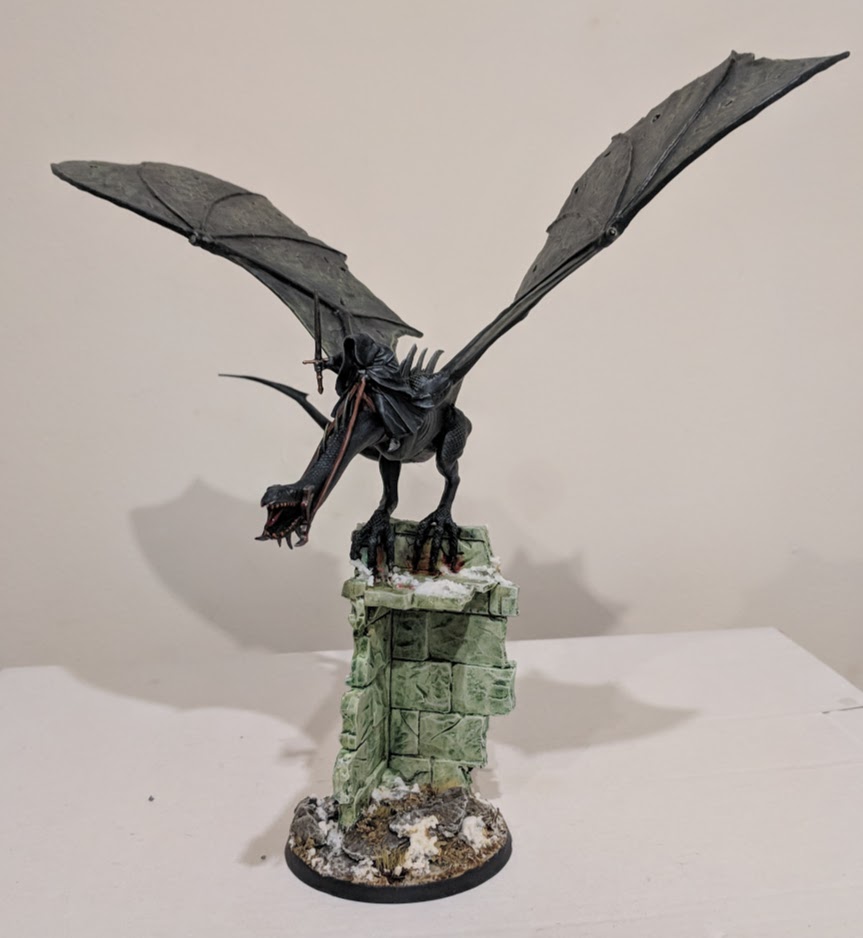
Do you remember the paint used for Arwen’s cloak? Incubi Darkness?
Many thanks
E
I think it might have been Vallejo Game Turquoise, washed all over with Army Painter Green wash, then highlighted with Vallejo Foul Green. Bit of a roundabout way to go about it, but it’s what I had on hand, haha.
Incubi Darkness looks like it would be a really close approximation!